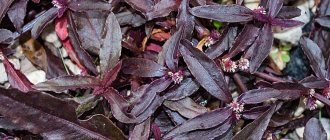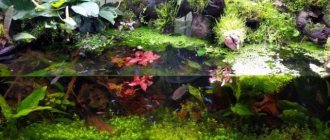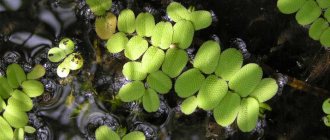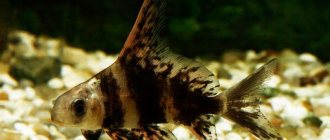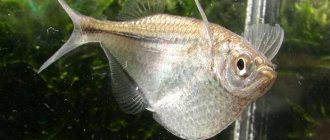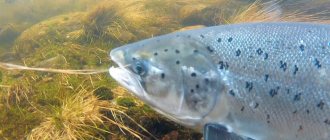Who lives in the pond?
The Amazon is home to a huge number of species. Let's look at the most popular representatives.
Predators
In the Amazon there is always a struggle for life; predators at the top of the food chain constantly compete with each other for food supply and territory, and often become each other's prey. Therefore, if we talk about who is found in the Amazon, then we should start with predatory species.
Fish
The most famous:
Arapaima (piraruku) is the queen of the underwater kingdom of the Amazon.
This fish reaches a length of up to three meters and weighs about 200 kg. There have often been cases where piraruku caused the sinking of small fishing boats of local residents.Pirarucu is a truly unique fish, its scales are real bones, which is why this predator is often called a “surviving fossil.”
This species is more than two million years old. Fish have the ability to breathe not only oxygen dissolved in water, but also grab air directly from the surface. Hunts other species of fish, birds and even animals. Arapaima is able to drag a fairly large monkey under water.
- Piranhas are small but dangerous monsters known to everyone. In fact, about 40 species of piranha live in the Amazon basin, and only 6 of them are predators. Rumors that piranhas can be dangerous to humans are mostly a myth. Piranhas are very timid fish, and they feel confident only when they attack small fish in a school. Piranhas reach 30 cm in length and live in large schools of up to 5,000 individuals throughout the river.
- The mackerel-shaped hydrolik is a fish that only vaguely resembles mackerel.
It has a length of up to 60 cm and huge jaws. The fangs of an adult hydrolic can reach 5 cm, with which it literally impales its prey during the hunt. Unlike piranhas, the fish is quite fearless, and sometimes attacks other predators that are larger than it. But the basis of the hydrolic’s diet is still smaller fish, such as piranhas. There have been no recorded cases of attacks on humans.
Animals
Most popular:
- The Brazilian otter is the mistress of the forests and tributaries of the Amazon.
Outwardly, it looks a little like a beaver, but is much smarter, more cunning and aggressive. They live in families of several individuals; sometimes an otter family numbers about 20 individuals, including cubs. When an otter grows up, it can leave its old family and create its own. They also hunt in groups, the prey being fish, small animals, and birds. A few adult otters can fight off even a black caiman, but cubs often fall prey. Alligators and anacondas are the only competitors of otters in the food chain.
The jaguar is the king of the jungle adjacent to the river.
A huge two-meter cat that hunts near the water, waiting for the animals to go to water. The diet consists of deer, capybara, anteaters and other small animals. Jaguars are distinguished by the fact that they can hunt in water, sometimes they themselves drag the victim to the bottom and drown it.- Taira is a South American marten. This is a fairly large predator, reaching a length of up to 60 cm (excluding the tail). They live solitarily in trees. They hunt rodents, birds, break bee hives, and can attack baby deer. The only threat to tairs is anacondas, which can climb a tree; they manage to avoid other predators.
Historical facts
The unique nature of this region attracted researchers already in the 10th century AD. e. The first settlement here was formed in the 13th century. Active exploration of the area began at the very end of the 15th century, after Christopher Columbus traveled to these places.
The greatest contribution to the development of the river was made by Conquistador Francisco de Orellano, who was the very first European to venture into the Amazon. His followers were the French scientist Aimé Bonaplane and the German geologist Alexander Humboldt. They were the first to climb up the Orinoco River to Casiquiare, to the place where the Orinoco mixes with the Rio Negro River.
It was thanks to them that it was established that the Orinoco River consists of two parts, which belong to different basins.
According to ancient records in chronicles, the first name of the river is “Sea Maria Holy”. This name was given by the Spanish explorer and comrade-in-arms of H. Columbus - Vincent Yansne Pinson. The river received its modern name “Amazon” in the 16th century, during the time of the Spanish conquerors, who took an active part in the times of American colonization.
During their stay on the river bank, they noted that the female population of the Indian tribe defended itself equally with the men. This reminded them of the Amazon tribe, which consisted only of women. This is how the river got its name.
Amphibians or amphibians
Top 3 most popular:
- The blue dart frog is a small but very bright frog. They live in small groups of up to 30-40 individuals. They differ in that both parents participate in the life of the offspring; this is rare among amphibians. They hunt insects. The bright coloring and poison that covers the skin of frogs helps them protect themselves from natural enemies.
- The terrible leaf climber is the most poisonous frog in the world, the poison of which can easily kill even an elephant. It lives in the headwaters of the Amazon, hunting in groups for insects and fish fry in shallow water. They do not become prey for predators due to their bright, deterrent coloring.
- The giant scolopendra is the largest scolopendra in the world. It produces several toxic compounds that attack prey. Hunts insects, spiders, small rodents. It often bites people, sneaking into the houses of local residents. Reaches a length of 35 cm.
Natural enemies
By nature, the arapaima fish is equipped with an excellent defense system. It is difficult to say who can cope with this strong and powerful creature. Some claim that there have been recorded cases of alligators attacking giant fish. But these precedents are extremely rare.
For some time, piranhas were considered natural enemies. But this statement is erroneous. Piranhas cannot cope with arapaima scales.
Due to its body size and scale armor, the arapaima rarely becomes a victim of attacks. The only enemy of this amazing creature is man. For residents of South America, hunting arapaima was a completely common, everyday activity.
“Amazonian Indians still consider arapaima red meat dishes to be their main delicacy.”
They catch giant fish using a harpoon or a net, which, thanks to centuries of practice, they do masterfully. To catch the creature, there are certain schemes developed over many years of fishing.
Fishermen are well aware of the nuances of the creature's respiratory system. They easily calculate at what moment the fish will appear on the surface of the water. The signal for them is the characteristic sound that an individual makes when capturing air.
Arapaima are caught in small lakes and reservoirs.
Arapaima meat is quite valuable and has a high price. It contains many nutrients. Fish bones can be used for medical and household purposes.
Yandex pictures
Reptiles or reptiles
- The black caiman is the rightful owner of the aquatic part of the Amazon. Anyone who comes into the possession of this large alligator for a watering hole will become its prey. They live alone, rarely in small groups, and hunt deer, monkeys, and fish. Sometimes even jaguars become their prey. Baby black caiman can become dinner for anacondas and agile flocks of otters.
Anaconda is a huge python that is famous for being able to strangle an adult crocodile.
Many films have been made about this reptile, but in fact, it is not so bloodthirsty. It does not attack people; its diet is based on small animals and fish.- The eyelash viper is the cutest snake in the world, but don’t be fooled, this “beauty” kills an adult rabbit in a few seconds. It is poisonous, hunts small animals, eats the eggs of other snakes. Often she herself becomes prey to larger snakes and birds of prey.
Amazing facts about the black caiman in the video:
Insects
The most popular are the following:
- Red ants are a real scourge for the inhabitants of adjacent lands during drought. They attack insects, but do not eat them, but take them to an anthill, which can be located even 10 km from the hunting site.
- The water bug is a predatory insect that resembles a beetle. Hunts in water, attacks small worms, fish fry and other insects. Cannibalism is common.
- Mosquitoes are annoying insects that drink the blood of animals and do not hesitate to attack people. They are dangerous because they are carriers of many diseases. They were the cause of many epidemics in Brazil.
Birds
The most common:
- Tinamu is a very interesting inhabitant of the Amazon. Resembles a giant quail up to 50 cm in length. Preys on small rodents, frogs and insects.
Vultures are legendary carnivorous birds.
They are not interested in small game; they attack medium-sized animals. But more often, they feed on carrion, eating scraps from jaguars or eating animals that have died of old age.- The wild-tailed kite is a small relative of the kites that live in Russia. Dimensions up to 30 cm, wingspan up to 70. They feed on snakes, insects, amphibians and small mammals.
Description
Kandiru are small fish. Adults can reach 16 cm, they have a small head and a stomach that can become very swollen, especially after another heavy meal (blood). The body of this catfish is translucent, which makes its detection in the muddy waters of the river very difficult. There are short sensitive antennae around the head, and on the gill covers there are spines with their points turned towards the tail.
An adult candiru.
Herbivores
Now it’s worth going lower down the food chain and considering the unique representatives of the herbivorous fauna.
Fish
All fish are actually predators. But you can consider fish whose diet is based on algae and nuts.
- Discus is the king of aquarium fish. Lives at the mouth of the Amazon River. One of the most beautiful local fish. Leads a peaceful lifestyle. Eats insects that have fallen into the water and underwater plants.
- Pacu is a fish that looks like a giant piranha; its teeth are terrifying, but the fish itself is very peaceful. She only needs her teeth to bite through nut shells.
- The red neon is another small fish that has captured the hearts of aquarists around the world thanks to its unusual appearance. They live in large flocks of more than 1000 individuals.
Animals
Among the herbivores, the most famous are:
The Amazonian manatee is a massive animal that poses no threat to other inhabitants. They live in families and eat pistia - river cabbage - in huge quantities.- Sloth - lives in trees, eating leaves. Rarely moves from its tree. During floods, sloths move through the water. They often become prey for caimans and anacondas.
- The capybara is the largest rodent in the world. They live in flocks, eating tree roots, berries, and bark. The weight of a capybara can reach 50 kg, and looks like a guinea pig.
Insects
Top 3 insects that are most often found:
- Termites are close relatives of cockroaches. They eat trees and live in large families. The hierarchy of termites is more similar to that of an ant.
- The giant cockroach is another endemic to the Amazon. A cockroach can reach 15 cm in length and weigh up to 30 g.
- Aphids are common throughout the world and the Amazon is no exception. Diet: tree leaves, live in huge colonies.
Birds
The three most famous and most frequently encountered:
- Macaw parrots - it was the Amazon that became their famous homeland. Beautiful colorful birds eat nuts and fruits. But it is worth noting that they also do not disdain insects.
- The hummingbird is the smallest bird in the world. The length reaches up to 3 cm, feeds on the nectar of flowers.
- Tananras are small birds that do not differ in size from the sparrows we are used to, but are bright red in color. They feed on plant seeds, but also eat insects. Both parents take part in caring for the offspring.
Characteristic
The Amazon River is famous for its close location to the equator. It occupies a large lowland area and has certain characteristics that have developed from natural conditions.
The river originates in the state of Peru at an altitude of 5,170 m, in the Andean mountains. It extends to the eastern part of Brazil and gradually drops to 3,500 m. The river flows parallel to the equator, from the western side to the eastern side. It is formed by the confluence of the Apachet, Ucayali and Marañon rivers.
Total length of the river:
| source | distance |
| Marañon | 6,400 km |
| Apache | 6,992 km |
| Ucayali | 7,100 km |
Until now, the scientific community has not come to a common conclusion which of the three sources should be considered the reference when calculating the length of the Amazon. The underground river Khamza flows under the Amazon River. It is located at a depth of more than 3.8 thousand m and is fed by underground groundwater. The largest width of the Amazon River is about 31 km, the deepest place reaches 36 m.
The river, together with ocean waters, forms the world's largest delta with an area of more than 100 thousand km². In the middle of the Amazon River there is an island called Marajo. It was formed as a result of the rise of the river bottom to the surface, subsequently several small islands connected. The area of the unique island is almost 55 thousand km².
20% of the total supply of fresh water that feeds the Atlantic is brought by the Amazon River.
When the fresh water of the Amazon mixes with the salt water of the ocean, active seething occurs on the surface, which is called the resulting Amazon tidal wave. Fresh water mixes very hard with salt water, and at a distance of 115 km from the confluence the water is fresh.
The Amazon carries its fresh water into the Atlantic at a speed of 4.5 m per second. In one second, the ocean water supply is replenished by 50 million liters of Amazonian water. The Amazon is the longest river in the world, with a record-breaking basin area. Together with the tributary called Tacantins, the area of the Amazon basin is almost 7,200,000 km².
The Amazon River is fed by rainwater and water formed after snow melts. Near its mouth there are about 500 tributary springs that constantly feed the Amazon. The main tributary of the Amazon is called the Marañon, its length is almost 1,420 km.
Other tributaries that provide the full flow of the Amazon:
Due to its location, the Amazon experiences warm equatorial weather with abundant rainfall. The year is climatically divided into 2 parts: wet and dry. The dry season lasts in this area from early August to late December. The temperature during this period can rise to +40°C with 100% humidity. At the same time, the water level of the Amazon River is minimal.
The period from the beginning of January to the end of July sees the heaviest rainfall. During this period, the temperature fluctuates around +20°C. At this time, sudden weather changes become more frequent here. In the morning and afternoon there are heavy rains, but in the evening the weather improves and the hot sun shines.
According to statistics over the past few years, annual precipitation averages 3 thousand mm. The average annual air temperature is +25°C.
Seasonality greatly affects the river level and its full flow. During the dry period of the year, the river spreads just over 10 km wide, its area during this period is 110 thousand km². During the rainy season, the river level rises by more than 14 m; the basin area can reach 150 thousand km². The highest water level in the river is in June, May and July.
| Name | approximate length (in km) |
| Isa | 1.6 thousand |
| Zhopura | 2.8 thousand |
| Rio Negro | 2.2 thousand |
| Shinga | 1.4 thousand |
| Purus | 3.2 thousand |
| Modeira | 3.3 thousand |
| Jurua | 2.4 thousand |
| Topajos | 1.9 thousand |
Vegetation of the reservoir
In addition to fauna, the Amazon has a rich species composition of vegetation:
Mangroves are unique trees that can grow underwater for a long time. The tree is so dense that it easily sinks in water.- Victoria Regia is a water lily plant that covers the entire water surface with its huge leaves. They are actively eaten by manatees and other animals.
- Eichornia , also called water plague. A plant that lives in water and reproduces at an unprecedented speed. When it came to Europe, people went to great lengths to get rid of it.
- The rubber tree is another endemic to the Amazon. This tree is the main source of rubber throughout the world.
- Water cabbage, pistia , is the most amazing plant that grows in the Amazon . Its uniqueness lies in the fact that during the rainy season it is the main source of food for many inhabitants of the river. It grows so quickly that it fills huge areas in a few weeks. Very nutritious, it allows manatees to survive during periods of drought.
Where does he live?
The main region of distribution is the Amazon River in South America in Peru and Brazil. Prefers muddy places with dense vegetation, as well as swamps and flooded areas. The optimal water temperature is +25...+29 degrees Celsius, as it has an acute reaction to changes in ambient temperature. During the dry season it lives in rivers and lakes, and during rainy periods it moves to flooded forests.
Interesting Facts
- 10 years ago, as a result of a worldwide referendum, the Amazon was recognized as one of the 7 natural wonders of the world.
- Under the Amazon, at a depth of 4 km, the world's largest underground river flows almost parallel to it.
- Due to its large width, no bridges are built on the river, except for one 3.5 km long.
- The Amazon is fed by more than 500 tributaries, of which 100 are considered navigable.
- The river's catchment area is comparable to the territory of Australia.
- The Amazon rainforest produces a quarter of the Earth's oxygen.
- In the jungle around the great river, there are still tribes of aborigines who are not familiar with civilization.
- The peculiarity of the Amazon lies in the variety of colors of the water: it can be dark, green, gray, milky and reddish.
Provides oxygen to the entire planet
The Amazon basin is not only home to unique plants and animals. Tropical rain forests supply oxygen to the atmosphere. However, every year people destroy more than one hundred thousand kilometers of unique flora. Moreover, forests are cut down not only in Brazil, but also in other countries. A perfectly functioning ecosystem can die and thereby push humanity towards disaster. The forest is the main supplier of oxygen, the air conditioner of our common planet. If the wealth of the Amazon basin can be preserved, Brazil will continue to be one of the most beautiful countries in the world.
Character of the great river
By the nature of its flow, the Amazon is a lowland river: almost along its entire length it carries its waters along a low-lying valley, and at the point where it flows into the ocean it forms the largest delta in area on the planet. Its regime is complex and unique due to its year-round high water supply.
This occurs due to rain falling at different times, supplying moisture to the left and right tributaries, as well as mitigating seasonal fluctuations in runoff. Therefore, the Amazon remains the deepest river in the world.


